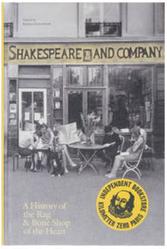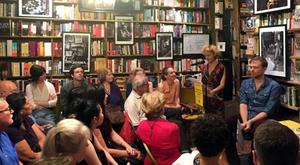"Welcome to the 'rag and bone shop of the heart,' " Sylvia Whitman greeted attendees at a gathering earlier this month at Shakespeare and Company in Paris. "This is an unusual event for us," she told the standing-room-only crowd in the store's cozy central rooms. "We're celebrating a book about the shop published by the shop."
 The reason for revelry is Shakespeare and Company, Paris: A History of the Rag & Bone Shop of the Heart, edited by Krista Halverson (dist. by D.A.P., $34.95, 9791096101009). Drawing on never-before-seen archives, it's the first book to share the full story of the legendary shop founded by Whitman's late father, George, an American expat, in 1951. A decade-by-decade narrative is interwoven with photographs, newspaper articles, poems, diary entries, and reminiscences by Allen Ginsberg, Anaïs Nin, Ian Rankin, Ethan Hawke, and others who have crossed the threshold of this literary landmark. It's also the first book to be published by Shakespeare and Company's new imprint, which Halverson is heading and which plans to publish "new writing and illustrated books, along with beautiful editions of classic texts and works in translation."
The reason for revelry is Shakespeare and Company, Paris: A History of the Rag & Bone Shop of the Heart, edited by Krista Halverson (dist. by D.A.P., $34.95, 9791096101009). Drawing on never-before-seen archives, it's the first book to share the full story of the legendary shop founded by Whitman's late father, George, an American expat, in 1951. A decade-by-decade narrative is interwoven with photographs, newspaper articles, poems, diary entries, and reminiscences by Allen Ginsberg, Anaïs Nin, Ian Rankin, Ethan Hawke, and others who have crossed the threshold of this literary landmark. It's also the first book to be published by Shakespeare and Company's new imprint, which Halverson is heading and which plans to publish "new writing and illustrated books, along with beautiful editions of classic texts and works in translation."
Halverson and other store employees and guests at the event, including novelist Jeanette Winterson, who wrote the foreword for Shakespeare and Company, Paris, entertained the audience, reading passages from the book and sharing anecdotes about George and the shop's famous clientele. (Along with Gregory Corso, Ginsberg once gave a poetry reading in the buff, after which George served fruit punch and cookies.)
A former "Tumbleweed," author Lynn Haney Trowbridge, read a piece she contributed to Shakespeare and Company, Paris about her ties to the store in the 1960s. Famous for his hospitality (and his Irish stew), George invited itinerant artists and writers in need of a place to stay to slumber gratis in beds nestled throughout the store. Some 30,000 Tumbleweeds have slept amid the stacks over the years, a tradition that continues.
 |
|
| Sylvia Whitman reading at Shakespeare and Company | |
Exactly five years to the day before the event, Halverson boarded a plane in San Francisco. Having left her job as managing editor of the art and literary quarterly Zoetrope: All-Story, she went in search of adventure abroad. During what was supposed to be a six-week stay in Paris, she contacted Sylvia Whitman and offered to volunteer at Shakespeare and Company. Soon Halverson was hired to oversee the creation of the bookshop biography. George had once thought to pen his memoirs but didn't get much past a title, The Rag & Bone Shop of the Heart, inspired by a line in a W.B. Yeats poem.
With George's cat as sidekick, Halverson spent more than a year organizing and archiving the plethora of papers and memorabilia stashed in George's apartment above the bookshop. (He died in December 2011 at age 98.) Thousands of newspaper clippings, letters, journals, and other miscellany were uncovered in wine crates and plastic tubs, tucked beneath George's bed, and even piled on top the toilet's water tank, which is where Gregory Corso's poetry-filled c. 1961 notebook was found.
Shakespeare and Company, Paris also illuminates the store's place in Paris history during the Cold War, the May 1968 student protests, the 1970s feminist movement and beyond. And the tome pays tribute to Sylvia Beach, proprietor of the original Shakespeare and Company, which closed in 1941 during the Nazi occupation of Paris. The first chapter is an engaging graphic story pairing excerpts from Beach's memoir with original illustrations.
One reason Halverson decided to structure the book by decade, from the 1950s to the 2000s, was to evoke the essence of the shop during particular times for those who have experienced Shakespeare and Company in person. The goal being that "the images and the text and the emotions would align perfectly with their own memories," she said. A reader has since reported to Halverson that perusing the 1970s chapter and laying eyes on a photo of a stairway adorned with the words "Live for Humanity" stirred recollections of how he happened into the shop by chance as a young man and stayed for a time.
"This is a place that has drawn millions of people over the last 65 years--readers, writers, bibliophiles, adventurers, and those with an open heart and a curiosity about others. This book is meant to feel like the bookshop," said Halverson. As she explains in the introduction, "I wanted to construct a book like a box of treasures that would be valuable both to those who know the shop well and to those who've only just learned of it." --Shannon McKenna Schmidt

